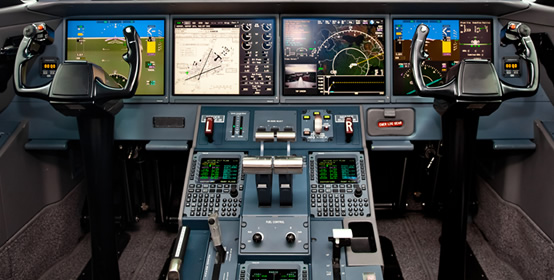
Artificial intelligence has been around for years, but the latest advancements in this area have people wondering if the future will truly resemble sci-fi shows like The Jetsons. Incredibly, top researchers have already been hard at work developing technologies that will allow airplanes to fly themselves. Currently, humans have the capability to make this vision a reality, but most experts believe that self-flying planes are more of a marketing issue than a technical one because people are not yet ready to trust the tech. Understanding the current automated features of piloting, the latest self-flying prototypes and futuristic AI visions helps create a more well-rounded and balanced approach to this newest AI tech advancement.
The concept of autopilot in airplanes has been around since 1947. Currently, autopilot is mainly used during level cruising while the human pilot takes over the controls for everything else. Autopilot is currently capable of handling the takeoff, climb, descent, approach and landing, but humans usually take over these tasks. Stephen Rice, a professor at Embry-Riddle Aeronautical University, explains that “pilots manually control the plane for about three to six minutes, and the rest is autopiloted”. Right now, the taxi phases of flights are not able to be automated.
There are several similarities between developing self-driving car AI and airplane autopilot AI, but the biggest distinction between the two is the differences in the complexity of pathways. Although traveling cars do have distinct highways and lanes, they are usually in a free-for-all state and can travel freely anywhere on the road. Air ways, on the other hand, are heavily controlled by air traffic controllers. Their flight paths, speeds, coordinates, directions and paths are all specifically guided by air traffic controllers, so the likelihood of crashes occurring is much lower than it is with cars on the road.
Several companies are developing self-flying prototypes. Boeing is testing out an entirely autonomous airplane. The plane will have a built in artificial intelligence machine that will make the decisions pilots usually make. A similar self-flying plane is being created by Airbus. The air taxi is called Vahana, and it is designed to travel short distances in urban environments. The plane is expected to get passengers to their destination twice as fast as cars. In emergencies, the Vahana will deploy a parachute that will protect any passengers. Airbus would need to install landing pads throughout the cities to launch the project. Dubai also plans on launching an autonomous aerial taxi service next year. The taxis are set to act like a sky shuttle service and travel on predetermined routes during its testing period. Volocopter’s taxis will be fully electric. Uber is partnering with experts in Dubai to help build their own future air taxi service.
Ultimately, self-flying planes will only become widespread if the public accepts the idea. A UBS global survey found that only around 17 percent of the 8,000 international respondents would be willing to fly in a self-piloted aircraft. The survey found that even a cheaper price could not entice most of the respondents to change their mind. Most of the younger generations were more likely to be willing to try out the technology, and the U.S. had the highest number of willing candidates.
While public perception appears to be the biggest road block to implementing futuristic AI technologies on a massive scale, it hasn’t seemed to slow down the progress that top scientists are making in this field of science. Advances in artificial intelligence technologies have been sweeping the globe at such a rate that experts have now created the world’s first platform for an entirely decentralized AI economy. Experts estimate that the AI economy will grow to be worth over $3.1 trillion by 2025. With the emergence of self-driving planes, autonomous vehicles, and robots with citizenship, it’s safe to say that the future is now!